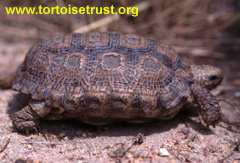
![]() Care and Maintenance of common South African tortoises; A Brief Summary
A. C. Highfield
Care and Maintenance of common South African tortoises; A Brief Summary
A. C. Highfield

South Africa has the richest tortoise diversity of any place on Earth. Some of these species, such as the endangered Geometric tortoise, are rarely encountered, but others, such as the Angulate, Leopard and Hinge-back tortoises are commonly maintained in captive collections both within South Africa and abroad. This brief summary highlights the most important considerations for each species and provides some hints on what to do should you encounter them.
Leopard tortoise: Geochelone pardalis
Angulate tortoise: Chersina angulata
Tent tortoise: Psammobates tentorius
Speckled Padloper: Homopus signatus
Common Padloper: Homopus areolatus
Bell's or Lowveld Hinge-back tortoise: Kinixys belliana
Savannah Hinge-back tortoise: K. belliana speckii
Prefers dry, scrubby habitats. Intolerant of cold and damp. Likes to drink frequently from standing water and also likes regular soaks. Diet must be very high in coarse, fibrous plants and especially grasses.
Similar habitat preferences to G. pardalis, but prefers looser, sandy substrates. Extremely susceptible to 'shell rot' type problems if kept on damp earth or similar substrates. This tortoise must be maintained on dry, sandy substrates if health problems are to be avoided. Grass lawns are not recommend as their humidity is too high. Diet should be rich in succulent plants, otherwise, same as G. pardalis.
The very name "Psammobates" means "sand loving". This tortoise is highly susceptible to shell disease, and above all to respiratory problems, if kept in a cold or damp environment. Enclosures must be sunny and very well drained. Juveniles do well in raised, artificial enclosures where they can be protected from the effects of ground humidity. Damp is the number one killer of this species in captivity. It is also highly susceptible to respiratory disease if mixed with other species. Maintain in strict isolation. The diet is essentially the same as for Chersina angulata, but with an increased preference for flowers.
The world's smallest tortoise - adult males are only 85 mm long. In captivity, it requires almost identical conditions to Chersina angulata, but with a strong preference for plenty of rocks to climb on and hide under. Highly intolerant of damp and cold. Do not mix with other species. Must have plenty of exposure to bright sunlight. If kept outside of its natural range, some indoor accommodation is almost essential. Diet as above.
Less delicate than H. signatus, but still requires a relatively dry, well-drained enclosure. Should not be mixed with other species.
This tortoise, unlike others described above, not only tolerates damp conditions but thrives in them. It is also surprisingly tolerant of cold, although obviously, it should ideally be provided with warm, moist conditions in captivity. It also differs in that this tortoise is highly omnivorous, and a high proportion of its diet comprises snails and millipedes. Water for soaking must always be available. Note that fat-saturated tinned dog and cat food is not a suitable substitute for snails or millipedes.
As for K. belliana. Occurs in somewhat drier habitats, however.